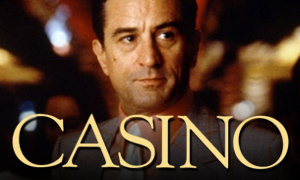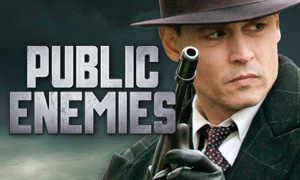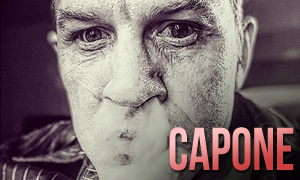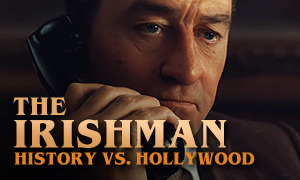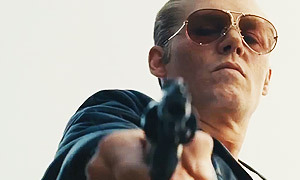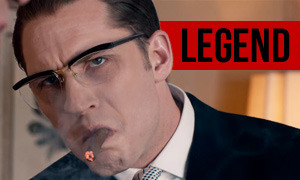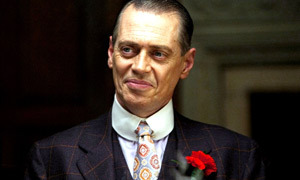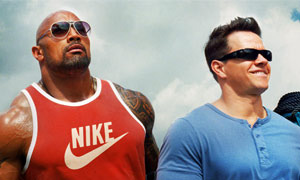The Irishman: History vs. Hollywood
| REEL FACE: | REAL FACE: |
Robert De Niro
Born: August 17, 1943 Birthplace: New York City, New York, USA | Frank 'The Irishman' Sheeran
Born: October 25, 1920 Birthplace: Camden, New Jersey, USA Death: December 14, 2003, Philadelphia, Pennsylvania, USA |
Al Pacino
Born: April 25, 1940 Birthplace: Manhattan, New York, USA | Jimmy Hoffa
Born: February 14, 1913 Birthplace: Brazil, Indiana, USA Death: July 30, 1975, Bloomfield Township, Michigan, USA (disappeared, presumed dead) |
Joe Pesci
Born: February 9, 1943 Birthplace: Newark, New Jersey, USA | Russell Bufalino
Born: September 25, 1903 Birthplace: Montedoro, Province of Caltanissetta, Sicily Death: February 25, 1994, Kingston, Pennsylvania, USA (natural causes) |
Jesse Plemons
Born: April 2, 1988 Birthplace: Dallas, Texas, USA | Chuckie O'Brien
Birthplace: Kansas City, Missouri, USA Hoffa's Unofficial Foster Son |
Sebastian Maniscalco
Born: July 8, 1973 Birthplace: Arlington Heights, Illinois, USA | Joseph 'Crazy Joe' Gallo
Born: April 7, 1929 Birthplace: Brooklyn, New York, USA Death: April 7, 1972, Manhattan, New York, USA (murdered by gunshot) |
Stephen Graham
Born: August 3, 1973 Birthplace: Liverpool, Merseyside, England, UK | Anthony 'Tony Pro' Provenzano
Born: May 7, 1917 Birthplace: Manhattan, New York, USA Death: December 12, 1988 (heart failure) |
Harvey Keitel
Born: May 13, 1939 Birthplace: Brooklyn, New York, USA | Angelo 'the Gentle Don' Bruno
Born: May 21, 1910 Birthplace: Villalba, Sicily, Italy Death: March 21, 1980, Philadelphia, Pennsylvania, USA (murdered by shotgun) |
Bobby Cannavale
Born: May 3, 1970 Birthplace: Union City, New Jersey, USA | Felix 'Skinny Razor' DiTullio
Born: August 3, 1907 Birthplace: Philadelphia, Pennsylvania, USA Death: April 1966 |
Ray Romano
Born: December 21, 1957 Birthplace: Queens, New York, USA | Bill Bufalino
Born: April 13, 1918 Birthplace: Pittston, Pennsylvania, USA Death: May 12, 1990, Fort Lauderdale, Florida, USA (leukemia) Teamsters Lawyer and Cousin of Russell Bufalino |
Welker White
Born: September 1, 1964 | Josephine Hoffa
Born: March 21, 1918 Birthplace: Rossford, Ohio, USA Death: September 12, 1980, Detroit, Michigan, USA |
Gary Basaraba
Born: March 16, 1959 Birthplace: Edmonton, Alberta, Canada | Frank Fitzsimmons
Born: August 7, 1908 Birthplace: Jeannette, Pennsylvania, USA Death: May 6, 1981, San Diego, California, USA (lung cancer) |
Did Frank Sheeran really confess on his deathbed that he killed Jimmy Hoffa?
Yes. According to The Irishman true story, Frank Sheeran did claim responsibility for the 1975 death of former Teamster leader Jimmy Hoffa. Prior to passing away from cancer, Sheeran told his story to Charles Brandt, who detailed it in his 2004 non-fiction book I Heard You Paint Houses. The bestselling book became the basis for the Frank Sheeran movie directed by Martin Scorsese.
Had Frank Sheeran served time in prison?
Yes. The FBI charged Sheeran with Labor Racketeering and he was given 32 years in prison. After nine years, medical malpractice lawyer Charles Brandt says he was retained by the Philadelphia mob to secure Sheeran's early parole on medical grounds at age 71. This is how Brandt, who would go on to write the book, became friends with Sheeran. Brandt had previously been a homicide prosecutor in the Delaware Attorney General's office from 1971 to 1976 and a criminal defense lawyer from 1976 to 1986.
Does Robert De Niro resemble the real Frank Sheeran?
Aside from the slicked-back hair and bit of excess weight, De Niro, who is 5' 10", does not bear much resemblance to the 6 ft 4 in Irishman Frank Sheeran. However, it's worth noting that while De Niro is known as an American-Italian actor, he is also of Irish descent on his father's side.
Did Frank Sheeran really develop his skills as a hitman while serving in WWII?
Per Sheeran's claims, he was part of numerous massacres and summary executions of German prisoners of war during his lengthy 411 days of combat. He described some of these in Charles Brandt's book I Heard You Paint Houses. Sheeran said that if a German soldier surrendered after killing one of his close friends, he would often "send him to hell, too." He said that other G.I.s demonstrated similar behavior.
In one instance, his unit came upon a German military mule train transporting food and water up the Harz Mountains. After allowing the female cooks to flee, he and his fellow soldiers "ate what we wanted and soiled the rest with our waste." According to Sheeran, they then handed the Wehrmacht mule drivers shovels and instructed them to dig their own graves, after which they executed and buried them. He commented that by that point, "[I] had no hesitation in doing what I had to do." This ability to take another person's life without pause undoubtedly paved the way for his role as a self-proclaimed hitman.
Sheeran told Brandt that the orders he received from his unit commanders in the army weren't any different than the orders he was later given by crime bosses. "It was just like when an officer would tell you to take a couple of German prisoners back behind the line and for you to 'hurry back'. You did what you had to do." -I Heard You Paint Houses
Was Frank Sheeran a central figure in the mob?
Not likely. We need only look to the fact that he was Irish and not Italian. This alone would have cast him as a peripheral figure in the Philadelphia mob. It could also be argued that Sheeran's home base of Scranton, Pennsylvania wasn't exactly a hotbed of mafia activity.
How did Frank Sheeran get to know Jimmy Hoffa?
After being discharged from the army in October 1945, a day shy of his 25th birthday, Frank Sheeran became a truck driver. To earn extra money, he committed crimes on the side. According to Sheeran, he worked as a hired enforcer and hitman. His criminal endeavors caught the attention of Mafia bosses Russell Bufalino and Angelo Bruno. Bufalino, who was the head of the Bufalino crime family, took Sheeran under his wing and became his mentor. It was Bufalino who hooked Sheeran up with the International Brotherhood of Teamsters president, Jimmy Hoffa, who oversaw the union whose members included truckers like Sheeran. The two became close friends, with Hoffa utilizing Sheeran for muscle and according to Sheeran, murder, both of uncooperative union members and enemies in rival unions. -I Heard You Paint Houses
Had Frank Sheeran been married twice?
Yes. The true story behind The Irishman supports that Sheeran married his first wife, an Irish immigrant named Mary, shortly after returning from WWII. They lived in Pennsylvania and had three children together. The pair divorced in 1968. Mary is portrayed by Aleksa Palladino in the Frank Sheeran movie. He then wed a woman named Irene, who is played by Stephanie Kurtzuba in the film.
What does the book's title mean, "I Heard You Paint Houses"?
The Irishman true story confirms that the book title "I Heard You Paint Houses" refers to killing someone. The "paint" is the blood that splatters on the floor and the walls. Like in the movie, these were also allegedly the first words that Jimmy Hoffa spoke to Frank Sheeran via a phone call. They connected by way of their common acquaintance, mob boss Russell Bufalino. Sheeran also supposedly mentioned the "paint splatters" during his confession to Hoffa's murder.
It might easily be assumed that this colorful analogy is part of well-known mob lingo. However, it's not. In fact, there seems to be no record of the phrase, "I heard you paint houses," being uttered anywhere except Charles Brandt's book. As a result, one has to wonder if it was ever actually said at all. Brandt reasons that mobsters in Bufalino's crime family in northeastern Pennsylvania "have their own lingo." Ultimately, it was literary agent Frank Weimann who chose to use the phrase for the book's title. -Slate
Did Frank Sheeran kill Crazy Joe Gallo?
This is one of the highly questionable claims that Sheeran made before his 2003 death, stating it during an interview with author Charles Brandt, who later included it in his book. Prior to Sheeran claiming that he was the lone gunman who killed Gallo, it had been widely accepted that Profaci crime family gangster Joe Gallo was murdered by four Italian-American gunmen associated with the rival Colombo crime family.
According to the original version of the events, a Colombo associate named Joseph Luparelli was sitting at the bar at Umberto's Clam House and spotted Gallo after he entered the restaurant. Luparelli left and alerted his fellow Colombo associates who were at a nearby hangout. Their boss gave them the go-ahead, and they burst into the dining room at Umberto's Clam House, shooting Gallo in the elbow, back and buttock. Convicted killer Carmine "Sonny Pinto" Di Biase was believed to have been the primary shooter. Gallo stumbled out of the restaurant into the street and collapsed. He was pronounced dead in the emergency room at Beekman-Downtown Hospital.
Frank Sheeran's story contradicts this, claiming that he was the lone trigger-man who took out Gallo. According to Sheeran, the murder had nothing to do with Gallo's feud with the Colombo family. Instead, it was due to the fact that earlier in the evening at the Copacabana nightclub, Gallo was rude to Sheeran's boss Russell Bufalino. With a nod from Bufalino, Sheeran knew what he had to do. How did Sheeran know which restaurant Gallo would be at later? Sheeran says that he was told by spies, who also gave him the exact location where Gallo would be sitting.
Author Brandt claims that in 2004, an editor at The New York Times saw Sheeran's photo in his book I Heard You Paint Houses. She had apparently been in Umberto's Clam House on the night of the shooting and immediately recognized Frank Sheeran as the lone gunman. However, this was 32 years after the shooting took place. In a more recent interview with Slate, she said that when she looked up toward where the shots came from, she saw a tall man who didn't exactly look Irish. She didn't recall seeing a gun in his hand. However, she still believes that man was Frank Sheeran.
Brandt says that NYPD Detective Joe Coffey, who was one of the detectives who ran the Gallo case, agreed that a very large, non-Italian lone gunman murdered Gallo (ClickOnDetroit). Yet, in Coffey's own 1992 memoir, The Coffey Files, he states that he was told by informants that Di Biase was the triggerman, as had long been believed. The opinions of the detectives in charge of the case can't be verified since they're all dead, including Coffey who passed away in 2015. We do know that the description of the shooter offered by witnesses and police at the time didn't match Sheeran. The New York Daily News described the gunman as "about 5-foot-8, stocky, about 40 years old and with receding dark hair." That describes Di Biase, not Sheeran. Furthermore, Joseph Luparelli became a government witness and explained how it went down, implicating Di Biase and three others in the shooting.
Sina Essary, Gallo's widow, was present at the restaurant where they were celebrating Gallo's 43rd birthday. She told Slate that the killers (plural) were "little, short, fat Italians." Again, that describes Di Biase and his associates, not the 6' 4" Irishman Sheeran. Gallo's bodyguard, Pete "the Greek" Diapoulas, who took a bullet that night, told New York Times reporter Nicholas Gage that Di Biase was the shooter. Gage, who spent years covering the mob for the Times and the Wall Street Journal and wrote the 1971 book The Mafia is Not an Equal Opportunity Employer (which dealt in part with Gallo), said of the Scorsese film and Brandt's book, "I haven't read the script of The Irishman, but the book on which it is based is the most fabricated mafia tale since the fake autobiography of Lucky Luciano 40 years ago." -Slate
What was the mafia's motive for killing Jimmy Hoffa?
Frank Sheeran was loyal to his mentor, Philadelphia mafia boss Russell Bufalino (pictured below). When Bufalino and other organized crime figures turned on Hoffa, Sheeran sided with Bufalino, betraying his friendship with Hoffa. When Jimmy Hoffa went to prison in 1967 for jury tampering, attempted bribery, and fraud (the result of Attorney General Bobby Kennedy's mission to bring him to justice), Hoffa installed a weakling named Frank Fitzsimmons in his place as the International Brotherhood of Teamsters president. Although Hoffa still had a voice from jail, Fitzsimmons was now in charge of the Teamsters Central States Pension Fund, a billion dollar fund. Under Hoffa, the loans made from the fund were legitimate, meaning he made sure they were collateralized and repaid into the fund. Fitzsimmons, on the other hand, made bad loans to the Mafia that were never repaid.
The Irishman true story reveals Hoffa was pardoned by President Nixon four years into his 13-year sentence. Sheeran said that this was because of a half-million-dollar bribe for Nixon that he personally delivered to Attorney General John Mitchell, which was money that had been skimmed from the mob-run Vegas casinos. Once out of prison, Hoffa intended to get his hands on the Pension Fund records and expose all the bad loans that Fitzsimmons made. Hoffa also planned to run for Teamsters president against Fitzsimmons in 1976, an election he would likely win. If Hoffa regained control of the pension fund, the mafia would lose their golden goose. Whacking Hoffa was a near-guaranteed way to solve the problem. -ClickOnDetroit
Besides Frank Sheeran's deathbed confession, is there any proof that he killed Jimmy Hoffa?
No. Sheeran's confession to his lawyer Charles Brandt that he murdered Jimmy Hoffa is the only evidence that exists. The confession is included in Brandt's book I Heard You Paint Houses. This isn't to say that the FBI hasn't tried to confirm Sheeran's claim. In 2005, they found 28 spots of blood in the house where Sheeran said that he shot Hoffa twice in the back of the head, subsequently dragging the body down a hallway. They managed to retrieve DNA from two of the spots, but it didn't match Hoffa. The exterior of the house can be seen in our video The Biggest Lie in The Irishman.
The fact that a forensics team didn't enter the home until almost 30 years after the July 30, 1975 disappearance of Hoffa has made it very difficult to prove if it was indeed the location Hoffa was slain. It is possible that further tests of the blood and the floorboards using advanced forensics techniques could confirm Sheeran's assertion. As of 2018, the FBI was unwilling to comment as to whether the new testing revealed anything (Riddle documentary). Therefore, The Irishman's version of Hoffa's demise remains speculation.
It has been argued that since the house is 20-25 minutes from the Machus Red Fox restaurant where Hoffa was picked up, it's unlikely that he would have been driven that far. It makes much more sense that he would have been driven to the home of Detroit mobster Carlo Licata, which was less than two miles away and not even a five-minute drive from the Machus Red Fox. You can see Licata's house in the linked video. Hoffa had been to Licata's home before for meetings, so there was a level of comfort there. In addition, the home sat up on a hill by itself, unlike the home where Sheeran claimed the shooting took place. Licata was a co-owner of Central Sanitation, the mob-run sanitation company where it is believed that Hoffa's body was disposed of, likely incinerated.
Prior to his deathbed confession, Frank Sheeran had long been suspected of playing some part in the disappearance of labor union leader Jimmy Hoffa. Sheeran was briefly mentioned in the FBI's Hoffex memo, which stated that he was "known to be in [the] Detroit area at the time of the JRH disappearance, and considered to be a close friend of JRH." The memo was put out by FBI agent Robert Garrity, who led the bureau's investigation into the disappearance of Jimmy Hoffa. It names a dozen men who were suspected of playing a role in the demise of Hoffa, including disposing of his remains.
While author Charles Brandt claimed that Agent Garrity told him that they "always liked Sheeran" for the disappearance, Garrity has subsequently refused to confirm that statement. In fact, Garrity's 57-page Hoffex memo states that while Sheeran was present in Detroit at the time and was likely involved in some way in the plot, it was actually mafia enforcer Salvatore "Sally Bugs" Briguglio who was "involved in [the] actual disappearance" of Hoffa. Prior to confessing, Sheeran had himself stated that Briguglio killed Hoffa. This is in line with the version of Hoffa's disappearance that has become the most widely accepted, that Sheeran, who was a friend of Hoffa, was possibly present in the car to put Hoffa at ease on the way to the "meeting," but it was Briguglio who played a key role in the murder. -Slate
How many people did the real Frank Sheeran kill?
I Heard You Paint Houses author Charles Brandt says that Sheeran confessed to him to killing 25 to 30 people. However, Sheeran couldn't remember an exact number. The problem with this is that Brandt never confirmed a single one of those killings. Furthermore, no actual evidence exists to prove that Frank Sheeran ever killed a single person. He had only been indicted but not convicted for ordering two murders (unrelated to Hoffa), but not for carrying them out.
Sheeran is also the only one who's ever alleged that Hoffa commissioned murder. Brandt's only proof of this is citing various times that Hoffa, who was known for his short temper and exaggerated remarks, said that he wanted to kill quite a few people, including John F. Kennedy, his brother Bobby, and others. However, there is no evidence that Hoffa ever actually followed through on any such statements, only speculation. -Slate
Was Frank "The Irishman" Sheeran religious?
Frank's parents were strict Roman Catholics. His father had spent five years studying for the priesthood and his mother attended Mass every morning. Frank is said to have been well-behaved up until his time serving in WWII. According to Frank, his 411 days in combat changed him. Prior to his death, he had embraced religion again and expressed remorse for his crimes. He wanted to die with a clear conscience. Author Charles Brandt says that Frank received Communion from a priest shortly before he died. -ClickOnDetroit
Did Frank Sheeran commit suicide?
While Frank Sheeran's official cause of death is cancer, author Charles Brandt claims that Sheeran starved himself to death in 2003 in a nursing home by refusing to eat, dying within six weeks of his final videotaped confession. He was 83. -ClickOnDetroit
Did they ever find the car that transported Hoffa on the day of his disappearance?
Yes. Authorities found the 1975 burgundy Mercury Marquis that a witness saw Hoffa riding in with unidentified men on the afternoon of his disappearance. The car was owned by Anthony Giacalone's son Joey and was being used by Hoffa's protégé Chuckie O'Brien (portrayed by Jesse Plemons in the movie). Search dogs picked up Hoffa's scent on the backseat of the car, but no other evidence could be matched to Hoffa. That is until 2001, when a hair found in the car was DNA tested and proved to be Jimmy Hoffa's.
What motivated Frank Sheeran to possibly make up the story that he killed Jimmy Hoffa?
The most logical reason that Frank Sheeran would confess on his deathbed that he killed Jimmy Hoffa was that Sheeran was broke and wanted to leave some money to his family. It's obvious that turning his life story into a book would sell much better if he was the one who pulled the trigger. Charles Brandt's book went on to become a New York Times Bestseller, and the author sold the movie rights to filmmaker Martin Scorsese. It's also important to note that Sheeran had previously said that he didn't kill Jimmy Hoffa. In 1995, he told the Philadelphia Daily News, "I did not kill Hoffa and I had nothing to do with it." In 2001, he said that Sal Briguglio was the killer (Al Profit).
Was author Charles Brandt involved in the Frank Sheeran movie that was based on his book?
Yes. Brandt was a script adviser on director Martin Scorsese's The Irishman, which is an adaptation of his book I Heard You Paint Houses. Steve Zaillian (Schindler's List, Gangs of New York, Moneyball) wrote the script.
What was the reason for the film's reported $200 million budget?
The main reason for The Irishman's ballooning budget was the special effects needed to make Al Pacino, Robert De Niro and Joe Pesci look up to 30 years younger for various scenes in the film. Industrial Light & Magic handled the de-aging. Netflix picked up the movie after Mexican financier Fábrica de Cine backed out due to the escalating budget. The Irishman is the most expensive film to date of director Martin Scorsese's career.
Overall, how accurate is The Irishman?
The movie was based on Charles Brandt's book I Heard You Paint Houses, which has itself faced a considerable amount of scrutiny. Certain claims that Brandt makes in the book have since been contested or proven false. This includes Brandt stating that the author of The Teamsters, Steven Brill, told fellow mob author Dan Moldea that he had recorded Frank Sheeran confessing to the murder of Jimmy Hoffa. In response to the book's assertion, Brill told Slate, "Total bulls**t. I would love to have had that. But I never talked to him."
New York Times journalist Selwyn Raab, author of a book about the attorney who represented Jimmy Hoffa, points out that there are 14 people who have claimed responsibility for Hoffa's death. Because no one was ever found guilty, anyone can claim responsibility. Thus, while Sheeran's claim is more believable than some, it is certainly not unique. Author Dan Moldea, who wrote 1978's The Hoffa Wars, has spent more than 40 years investigating the Teamsters, including unearthing everything he could about Hoffa's disappearance. He says that Frank Sheeran "was definitely involved, but he confessed to a murder he didn't commit." Moldea expressed anger that his research, including interviews with over 1,000 people, was overlooked by Hollywood for a book that was based almost entirely on the word of one man, who was a convicted felon.
Skeptics of Sheeran's claim, and there are many, argue that it's difficult to believe given the other somewhat outlandish claims he made, which include delivering a bag of three rifles to a pilot to be used in the 1963 Kennedy assassination, playing a role in the provisioning of the anti-Fidel Castro forces who took part in the Bay of Pigs invasion (he said he delivered weapons to CIA agent E. Howard Hunt, who a decade later would become one of the Watergate burglars), and delivering $500,000 in cash to Attorney General John Mitchell (a bribe for President Richard Nixon to pardon Hoffa). Such claims make Sheeran seem more like Forrest Gump than a realistic mob enforcer (in reality, he has been described by some as a well-known drunk). Oh, and then there was the letter that Sheeran forged, which he said was from Jimmy Hoffa. The discovery of the forgery led at least one publisher to back out of a deal to publish Brandt's book I Heard You Paint Houses, which became the basis for the movie. Brandt finally got his book published on the third try.
After coming forward with his confession, Frank Sheeran was interviewed by Maria Shriver for NBC-TV's Washington Bureau, but the interview never aired, reportedly because Sheeran was caught in too many lies (The Hoffa Wars). The claims in Brandt's book have been rejected by those who are arguably more knowledgeable and those who are closer to the case. The overwhelming majority of the book rests on claims made by Sheeran himself, who can hardly be seen as credible. Brandt and his publisher have challenged critics of the book, calling their critiques "borderline libel" and asking them for proof that Sheeran didn't kill Jimmy Hoffa and Joey Gallo. It's a ridiculous request given that Brandt's book doesn't provide any proof that Frank Sheeran ever killed anyone, including Hoffa and Gallo. Therefore, the burden of proof remains with Brandt.
The only person who ever accused Frank Sheeran of killing anybody, including Jimmy Hoffa, Joey Gallo, and 25 to 30 other people, is Frank Sheeran himself (Slate). Mobsters don't have a history of getting away with repeated crimes for very long. They often get arrested multiple times or end up dead. Some stories are just too good to be true. Enter director Martin Scorsese, who appears to be more concerned with making a memorable movie than one that gets at the true story. Arguably, maybe that's to our benefit, but it's certainly not history's gain.
Frank Sheeran Interview & Related Videos
Watch clips of the real Frank Sheeran discussing his role in Jimmy Hoffa's disappearance. Then further expand your knowledge of the true story behind The Irishman by watching mob boss Russell Bufalino testifying about his relationships with Jimmy Hoffa and Frank Sheeran.
